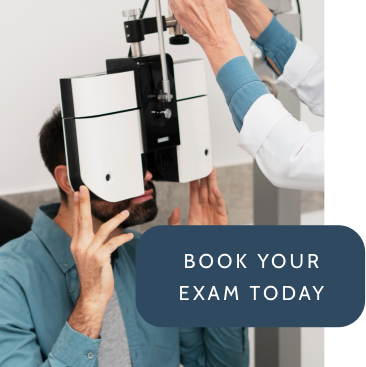If you’ve ever spent too much time at a computer or reading a book in low-light conditions, you may have felt a form of tiredness, strain, or discomfort in your eyes. Commonly called eye strain or eye fatigue, this feeling is caused by overworking the eyes for an extended period of time. But how long does this feeling last? Does it go away?
Eye strain is typically a temporary condition. It tends to go away after a few hours, but if left unaddressed, symptoms may continue for up to a few days. It can help to speak with your optometrist so they can determine what’s causing your feelings of eye strain.
What Is Eye Strain?
Eye strain, also called eye fatigue, is a common condition that develops when the eyes are overworked or tired from extended or intensive use. It’s most often caused by prolonged activities that require intense focus, like reading small print on a screen or focusing on minuscule details when working.
It often causes:
- Soreness
- Discomfort
- Headaches
- Blurry vision
- Light sensitivity
- Dry eye syndrome
This condition is a common development, but it can be easily treated with the help of your optometrist or by making lifestyle adjustments.
What Causes Eye Strain?
Since strain is caused by the eyes overworking themselves, there’s a wide range of potential factors—all closely related to prolonged intense focus. They include:
- Extended screen time
- Wearing the wrong glasses or contact prescription
- Working in an environment with poor lighting
- Reading in low-light conditions
In some situations, chronic eye strain can be caused by an undiagnosed vision problem like nearsightedness or farsightedness, making it even more essential to regularly visit an optometrist for comprehensive eye exams.
How Long Does Eye Strain Usually Last?
When you’re feeling eye strain, you may be looking for any sort of relief, so it’s perfectly natural to wonder how long to expect this condition to last. Unfortunately, there is no set timeline before it goes away—it depends on the underlying cause. Symptoms can also vary in severity or duration depending on the person.
For some people, eye strain may go away within a few minutes or hours. However, if the condition’s underlying cause isn’t properly addressed—or if their symptoms are more severe—it could take up to several days before symptoms recede.
Some people may find that their eye strain continues returning, especially if they continue participating in activities that make it worse. It’s important to note—one of the better ways to reduce eye strain is to implement preventative measures to avoid the development in the first place.
If your eye strain continuously persists or worsens despite efforts to alleviate it, this could be an early sign of an underlying eye condition. If you notice any significant pain, light sensitivity, or headaches, you should seek medical advice as soon as possible.
You can take steps to reduce eye strain in your everyday life.
How to Reduce Eye Strain
When trying to reduce—or avoid—eye strain, it can help to:
- Follow the 20-20-20 rule when using close-up screens. Every 20 minutes, look at something 20 feet away for roughly 20 seconds. This can help your eyes relax and adjust, giving them a break from overworking themselves.
- Ensure you work and spend your time in a properly-lit environment.
- Adjust your screen settings on your devices. Many devices, televisions, and computer monitors allow you to adjust the contrast, font size, and brightness. Setting these to a more comfortable setting can help avoid straining your eyes.
- Set up your workplace in an ergonomic way. Position your screen at eye level and make sure your chair is comfortable.
- Blink regularly. When focusing on something near your face, it’s a common occurrence to blink less.
- Stay hydrated, as this can help keep your eyes moisturized.
If you have contact lenses or glasses, it can help to wear them as recommended. Take some time when needed and check that they’re clean, scratch-free, and up-to-date in their prescription.
Customized Solution for Reducing Eye Strain
At Dr. Zargar Eyecare, we offer custom lens solutions for reducing eye strain for your day-to-day.
- Home & Office: allows for you to see intermediate distances and reading. This lens allows for moving around in the office or home
- Online Wide: ideal for those working on a computer. This lens allows you to view multiple computer screens without moving your head, and is best for close-up reading.
Work With an Optometrist
However, when trying to reduce eye strain, you can take one important step: work closely with your optometrist.
Seeking the advice of an experienced professional trained in caring for the human eye can be extremely beneficial. They can perform a thorough, comprehensive eye exam and may be able to determine what’s causing your eye strain. Then, they can give you a recommendation for reducing this feeling in your everyday life.
To speak with a caring professional today, book an appointment with us at Dr. Zargar Eyecare.



















